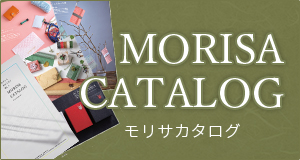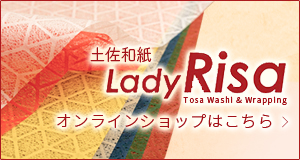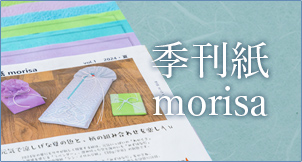About Morrisa’s Products
→ Are fluorescent dyes used?
→ Is Japanese paper resistant to heat?
→ Is Japanese paper resistant to water?
→ Can I use cut paper, etc. for food products?
→ Can thick Japanese paper be sewn?
→ What is the best way to cut thin Japanese paper?
→ What is the best way to apply Japanese paper?
→ Aren’t Japanese paper bags easily torn?
→ Can I make Japanese paper lanterns?
→ Can I use Washi on my computer?
→ Does it not bleed when written with a pen?
→ Can it be wrapped in Japanese paper and frozen or refrigerated?
→ Is it suitable for calligraphy?
→ Can I use it for Chigiri-e?
→ Are you good at picture writing?
→ Can I use it for origami?
→ How do I use the small rolls?
Q.Do you use fluorescent dyes?
A.
Please be assured that we do not use any fluorescent dyes in our paper manufacturing process.
Q.Is Japanese paper resistant to heat?
A.
General Japanese paper is resistant to heat to the extent that wrinkles can be ironed out, but this is not the case with composite materials.
For example, if the paper has been heat-sealed to make a bag, it will begin to dissolve at about the medium temperature of an iron.
Q.Is Japanese paper water-resistant?
A.
It is well known that paper is weak against water, and untreated Japanese paper will tear easily when it is dripped with water, but it is possible to make “water-resistant washi” by adding waterproofing treatment, as we know that Japanese umbrellas coated with persimmon tannin and waterproof paper coated with konjac were used for clothing in the past. It is possible to make “water-resistant washi” by adding waterproofing and other processes.
Q.Can I use cut paper, etc. for food products?
A.
Morisa paper does not use any fluorescent dyes, so white paper can often be used without problems. However, we do not recommend using paper that contains dyes or pigments, gold or silver foil, or plant fibers in such a way that it comes in direct contact with food.In such cases, we often use a lamination process.
Q.Can thick Japanese paper be sewn?
A.
Although thick paper or paper reinforced with konnyaku or persimmon tannin can often be sewn, it is best to avoid sewing long lengths of paper, as the weight of the paper can easily tear the sewn surface.
Q.What is the best way to cut thin Japanese paper?
A.
Washi has longer fibers than most paper, so it often does not cut well when torn by hand, but it can be cut cleanly by holding a scale with a cutter or similar tool and cutting with the blade applied vertically.
Also, fir paper and other paper with a wrinkled surface can be cut cleanly with scissors.
Q.What is the best way to apply washi?
A.
As with regular paper, either starch glue or paper adhesive may be used.
Please note that cellophane tape with low adhesiveness may peel off easily.
Q.Aren’t Japanese paper bags easily torn?
A.
Many people think that the material of Japanese paper is soft and will tear easily, but it has a unique bounciness.
Some products are laminated with film to hold heavy or moisture-resistant items.
If you are concerned, please request a sample and try it out before considering the product.
Q.I want to make Japanese paper lanterns.
A.
Because washi has a unique texture, we receive many inquiries about how to enjoy it with lights.
However, paper is a flammable material by nature, so be careful to use the light source 5 to 6 cm away from the paper so that it does not touch the paper.For light sources that generate heat, such as incandescent bulbs, be sure to create a hole at the top to allow heat to escape by convection. Recently, there are light sources that generate almost no heat, such as LEDs, so we recommend using such devices.
Q.Can I use Washi on my computer?
A.
In response to requests to use washi in PC inkjet printers, Morisa has developed washi that can be used in printers using a process called WA-MIX.
Conventional Japanese paper products may bleed or fail to feed paper properly, so be sure to use products labeled “for PC, OA, inkjet” or similar.
Q.Does it bleed when I write with a pen?
A.
Not all paper is suitable for pen writing.
Washi was used for writing with a brush until the Edo period (1603-1868), so in order to write with a pen, it must be treated to “stop blotting,” and such washi is often deliberately labeled as “for pen writing.
Q.Can I wrap it in Japanese paper and freeze/refrigerate it?
A.
Please note that while wrapping on Japanese paper and then freezing or refrigerating rarely causes problems with the paper itself, it is susceptible to condensation = water after it is removed from storage.
When used as wrapping material for these conditions, it is not recommended to use thin paper by itself.
When considering Washi as a wrapping material, it is essential to test it in and out of the warehouse under your company’s conditions.
Q.Is it suitable for calligraphy?
A.
In calligraphy, there are cases where large blotches are used for writing, and other cases where paper without blotches is preferred, such as for kana writing. (Link to Morisa’s Yuuso)
Q.Can I use it for chigiri-e?
A.
Long fiber paper seems to be used for chigiri-e, but “handmade” washi, which can be delicately torn, is preferred.
Q.Is it suitable for pictorial paper?
A.
Paper with moderate bleed-through is preferred for pictorial paper.
Morisa’s “Youso postcards” have been well-received for their ability to successfully express the blurring of sumi ink and pigments.
Q.Can I use it for origami?
A.
It is difficult to generalize about origami, as there seems to be a preference for both thick and thin paper styles, but it seems that foldable materials with texture are preferred.
Thinner papers such as lace washi may be purchased for origami.
Q.How do I use the small rolls?
A.
The shape of the Komaki roll was born out of the field of florists, confectioners, and other shops that frequently need to wrap items of unspecified shapes.
It is very convenient to place it by the work table and take as much paper as needed for cutting, just as you would use paper towels. It is also very popular in places where a large number of people use paper, such as daycare centers, schools, and various facilities.






